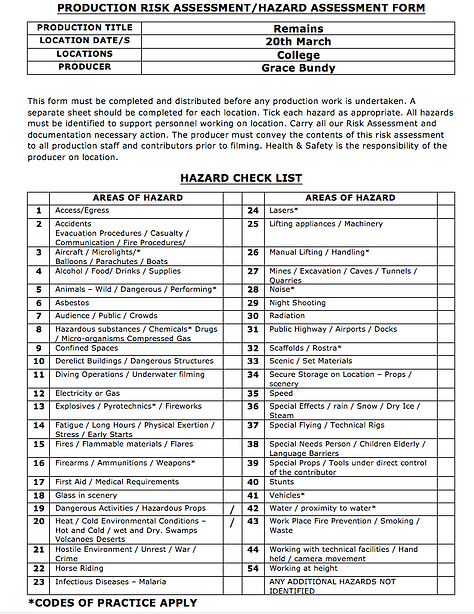Grace Bundy
Investigating visual production and technology
180 degree rule- the different camera angles that show when 2 people are having a conversation and the angles are switching but are staying on one
eye-line match- It starts with the audience are seeing what the characters face while they are looking at something. It then cuts to the audience seeing what the character is seeing from their perspective
match on action- is where the camera shot shows a close up of something and then the same thing happening but from a different view.
rhythmic match- a sequence of shots that fit a rhythmic pattern. Characteristics: a shot's physical length corresponds to a measurable duration. rythmic function occurs when several shot lengths form a distinct pattern.
graphic match- a transition between 2 shapes or objects that are similar which are used to link them metaphorically
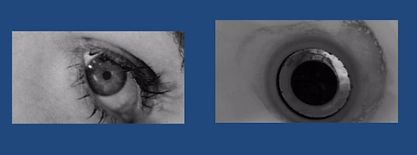

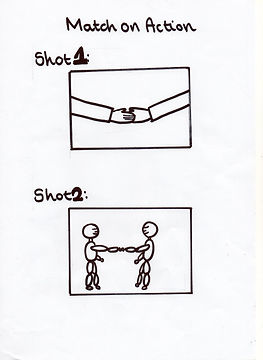
Remains
On another occasion, we got sent out
to tackle looters raiding a bank.
And one of them legs it up the road,
probably armed, possibly not.
Well myself and somebody else and somebody else
are all of the same mind,
so all three of us open fire.
Three of a kind all letting fly, and I swear
I see every round as it rips through his life –
I see broad daylight on the other side.
So we’ve hit this looter a dozen times
and he’s there on the ground, sort of inside out,
pain itself, the image of agony.
One of my mates goes by
and tosses his guts back into his body.
Then he’s carted off in the back of a lorry.
End of story, except not really.
His blood-shadow stays on the street, and out on patrol
I walk right over it week after week.
Then I’m home on leave. But I blink
and he bursts again through the doors of the bank.
Sleep, and he’s probably armed, and possibly not.
Dream, and he’s torn apart by a dozen rounds.
And the drink and the drugs won’t flush him out –
he’s here in my head when I close my eyes,
dug in behind enemy lines,
not left for dead in some distant, sun-stunned, sand-smothered land
or six-feet-under in desert sand,
but near to the knuckle, here and now,
his bloody life in my bloody hands.
Analysis-
There are many different themes in this poem including guilt, conflict and life and death, which is why I think that this poem is very interesting. I also like the structure of this poem as it is a monologue which I think will be good to narrate as it is a fast paced poem as it includes enjambment. It also has lots of rhythm which will also be good to narrate. I like that the poem can be interpreted in different ways which is why it will be good to choose this poem. I think that because this poem has lots of imagery it creates a more intense emotion and makes the reader feel sorry for the person who's memories have stayed with him.
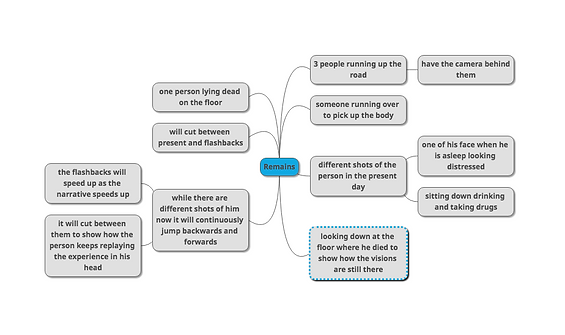
Detailed visual narrative
In my visual narrative of this poem I would have someone running up a straight road with 3 people chasing after them. I will then cut to the person fall to the floor and have a shot of someone laying there dead. One person will run over to pick up the dead person and has a slow motion of the dead person being carried away. "end of story" at this point I will have a pause and have a black screen, as if to represent the second part of the poem. I will then have someone looking down at the floor where the person died and will have a quick flash back to when he was lying on the floor, to show what the person is thinking about. I will then have a close up of someone blinking and then cutting to the person running up the road (going to raid the bank). A close up of someone taking pills with a flashback to when he got shot. The person asleep now looking more distressed different shots and angles used to show how the visions are more vivid. I will then have all the shots of the flashback sped up playing over and over until the narration is over to show how the person is still remembering the experience.
War photographer
In his dark room he is finally alone
with spools of suffering set out in ordered rows.
The only light is red and softly glows,
as though this were a church and he
a priest preparing to intone a Mass.
Belfast. Beirut. Phnom Penh. All flesh is grass.
He has a job to do. Solutions slop in trays
beneath his hands, which did not tremble then
though seem to now. Rural England. Home again
to ordinary pain which simple weather can dispel,
to fields which don’t explode beneath the feet
of running children in a nightmare heat.
Something is happening. A stranger’s features
faintly start to twist before his eyes,
a half-formed ghost. He remembers the cries
of this man’s wife, how he sought approval
without words to do what someone must
and how the blood stained into foreign dust.
A hundred agonies in black and white
from which his editor will pick out five or six
for Sunday’s supplement. The reader’s eyeballs prick
with tears between the bath and pre-lunch beers.
From the aeroplane he stares impassively at where
he earns his living and they do not care.
Analysis-
The structure of this poem is very interesting as it has a rigid order which contrasts with the chaotic visions that is described in the poem. The main themes in this poem is the horror of war and the increasing indifference to the victims of conflict. The poem changes in each stanza as his observations change in the first 3 stanzas and then there is a conclusion in the last stanza. I think that because of the structure of this poem it makes it interesting to narrate and because there is lots of imagery it will make the visual narrative even more interesting. This poem makes me appreciate how much people have to go through and witness to just see a picture in the newspaper.
Detailed visual narrative
In my visual narrative I would have someone standing in a dark room with a red glow surrounded my pictures that are in strays of water. He hands trembling as he puts the picture in the trays. It would then cut to lots of people running through a street to represent a flashback.it would then cut to the persons eyes then cut to his wife screaming on the floor. It would then cut to the pictures being given over and then cut to just 1 of the pictures in the newspapers.
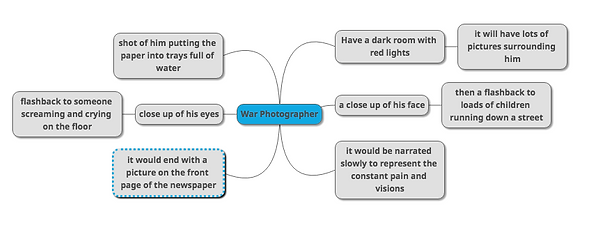
Bayonet Charge
Suddenly he awoke and was running – raw
In raw-seamed hot khaki, his sweat heavy,
Stumbling across a field of clods towards a green hedge
That dazzled with rifle fire, hearing
Bullets smacking the belly out of the air –
He lugged a rifle numb as a smashed arm;
The patriotic tear that had brimmed in his eye
Sweating like molten iron from the centre of his chest,
In bewilderment then he almost stopped –
In what cold clockwork of the stars and the nations
Was he the hand pointing that second? He was running
Like a man who has jumped up in the dark and runs
Listening between his footfalls for the reason
Of his still running, and his foot hung like
Statuary in mid-stride. Then the shot-slashed furrows
Threw up a yellow hare that rolled like a flame
And crawled in a threshing circle, its mouth wide
Open silent, its eyes standing out.
He plunged past with his bayonet toward the green hedge,
King, honour, human dignity, etcetera
Dropped like luxuries in a yelling alarm
To get out of that blue crackling air
His terror’s touchy dynamite.
Analysis-
The three stanzas have lots of imagery which is why it would be a good poem to choose. You can see and hear the images as when you read it the sounds of the words represents something else, for example: there is a repeated 'h' sound which expresses the soldiers heavy breathing. This occurs lots in the poem which I like. I like how there is a clear change in his emotions throughout the poem. When I read this poem I liked the metaphors that was used and how that could be interpreted in different ways.
Detailed visual narrative
It would start with someone stumbling through a field with the sounds of rifles in the air. There would be different close ups like his eyes that are close to tears, whilst he is still running. Then he starts to slow down and nearly stops with a vision in his head of him dead on the ground. Then he would start to run again, and speed up as if now he didn't care about being brave and just wanted to survive, a close up of his face here to show how his feelings have now changed and now he just wants to survive.
The main focus of this poem is to show how the soldiers different close up shot of his face and body whilst he was running to show how his opinions have changed.

My chosen Poem
I have chosen to do my visual narrative on remains because I think that it will be the most interesting to film. I will have lots of different clips from the present and past and will switch between them both to make it more intense. I will also switch between the clips more as the poem gets nearer the end as I will increase the speed of the narration. I think that it is more interesting then the other poems as it has as it had lots of imagery which will make it easier to create the visual narrative. The visual narratives ideas that I have for remains are also more then I have for the two other poems as that is the one that I think is the best poem. I don't have many different clips but I will make sure that I get lots of different angles to make sure that it doesn't become to boring and repetitive. I decided not to go with war photographer because of the setting which would be very difficult to recreate. I also didn't have as many creative ideas as I did for Remains. With remains I had a lot more visual narrative ideas and thought that it would show more of the editing skills that I have, and I wouldn't be able to show this in war photographer. I decided not to choose Bayonet charge because there was not many different scenes that I would be able to film as they all seemed very similar. I also didn't think that there was much visual narrative that I could include and I would struggle with the settings so I decided not to do this poem. I think that Remains has the most interesting visual narrative and I think that I will be able to make the narrative more interesting as I can change the speed of it so that it sounds better. However I struggled to think of other ways that I could change the narrative of the other poems to make it more interesting. I think that because I think in general that it is a better poem because of the flashbacks and the imagery that is used I think that it helps me to come up with better ideas.
Shot List-
Scene 1- front view as he looks behind then cut to his view on the 3 guys (eyeline)
side view as running
running away from camera (behind shot)
Scene 2- front view linking with scene 1 (eyeline) looking back at the 3 guys running towards the camera
Scene 3- close up side view of guy shooting (pulling the trigger)
birds eye view (looking down) on dead body
Scene 4- far away front view dragging the person away
Scene 5-far away front view walking down the street
Scene 6-close up of him looking down and a vision of the person on the floor
Scene 7-zoom into eyes and then blinks
Scene 8-zoom into face while he is sleeping
Scene 9- after the flashback cut back to him sleeping again
Scene 10- middle view on sitting on the chair drinking
Scene 11- continuous flashback
Scene changes
Scene 1-
On another occasion, we got sent out
to tackle looters raiding a bank.
And one of them legs it up the road,
probably armed, possibly not.
Scene 2-
Well myself and somebody else and somebody else
are all of the same mind,
so all three of us open fire.
Scene 3-
Three of a kind all letting fly, and I swear
I see every round as it rips through his life –
I see broad daylight on the other side.
Scene 4-
So we’ve hit this looter a dozen times
and he’s there on the ground, sort of inside out,
pain itself, the image of agony.
Scene 5-
One of my mates goes by
and tosses his guts back into his body.
Then he’s carted off in the back of a lorry.
Scene 6-
End of story, except not really.
His blood-shadow stays on the street, and out on patrol
I walk right over it week after week.
Scene 7-
Then I’m home on leave. But I blink
and he bursts again through the doors of the bank.
Scene 8-
Sleep, and he’s probably armed, and possibly not.
Scene 9-
Dream, and he’s torn apart by a dozen rounds.
Scene 10-
And the drink and the drugs won’t flush him out –
Scene 11-
he’s here in my head when I close my eyes,
dug in behind enemy lines,
not left for dead in some distant, sun-stunned, sand-smothered land
or six-feet-under in desert sand,
but near to the knuckle, here and now,
his bloody life in my bloody hands.
Secondary research
https://www.theatlantic.com/health/archive/2015/07/healing-a-wounded-sense-of-morality/396770/
- After looking at this secondary research I found out that lots of soldiers that comeback from war have a lot of regret and guilt which stays with them. There are different organisations that are about so that they can get help with their problems and issues. killing was strongly linked to later depression, alcohol abuse, anger, and relationship problems- this is a quote from the website which I found very interesting and useful to my poem. This is because in my poem it is based about his mental health after he has killed someone, and it is also spoken about this in this website.
Looking at this secondary research it has helped me with my poem as I understand more about the problems that they go through, and now I can portray this in my poem in more of a realistic way as I have now got a better understanding of it.
- Context of 'Remains'
Simon Armitage’s poetry is known for its colloquial style, strong rhythms and voice. He deals with personal relationships, often drawing on his own life experience. He often uses the monologue form in his poetry to create immediate and moving characters. His delivery is deadpan and sometimes darkly humorous.
The reference to 'desert sand' suggests this poem is set in the Gulf War
This particular poem lacks the humour of some of his other work and instead presents a dark and disturbing image of a soldier suffering post-traumatic stress disorder.
Armitage made a film for Channel 4 in 2007 called The Not Dead and has a collection of poems of the same name, from which this poem is taken. In preparation for this work, he interviewed veteran soldiers of different wars, including the Gulf War. The reference to ‘desert sand’ in this poem suggests that it reflects the experiences of soldiers in the Gulf War.
This is from the bbc bitesize website which explains some context behind the poem which will help me with my visual narrative. It explains that the poem was set in the gulf war which is why there is a reference to 'desert sand' which gives me a better understanding of what that part was referring to. After looking at these websites it has helped me with my own poem because I have now got a better understanding of the meanings within the poem. I have also got a better understanding of why the soldier in this poem is having all these effects after the war and I think that it will help me to portray a more realistic view of life after war.
- I also did research into PTSD so that I could understand the disorder more. I used the NHS website to look into it more, the website gave an overview of the disorder and how it would be caused.
Post-traumatic stress disorder (PTSD) is an anxiety disorder caused by very stressful, frightening or distressing events.
Someone with PTSD often relives the traumatic event through nightmares and flashbacks, and may experience feelings of isolation, irritability and guilt.
They may also have problems sleeping, such as insomnia, and find concentrating difficult.
These symptoms are often severe and persistent enough to have a significant impact on the person’s day-to-day life.
The type of events that can cause PTSD include:
-
serious road accidents
-
violent personal assaults, such as sexual assault, mugging or robbery
-
prolonged sexual abuse, violence or severe neglect
-
witnessing violent deaths
-
military combat
-
being held hostage
-
terrorist attacks
-
natural disasters, such as severe floods, earthquakes or tsunamis
From this information it has helped me to understand the disorder more so that I could show it in my visual narrative. I learnt what the problems it causes and how some of them are said in the poem.
- After doing all of this secondary research it has helped to have a better understanding of PTSD and how if effects people, which will help me in my own visual narrative when showing the after effects of war on this person. By looking at the context of remains it has helped to understand what the poet was trying to convey and it gave me an insight into how he came up with the idea for this poem. Now that I know that it was set in the Gulf war I have now got a better idea and understanding of the poem making it easier for me to do a visual narrative.
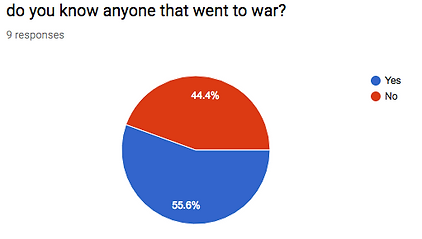
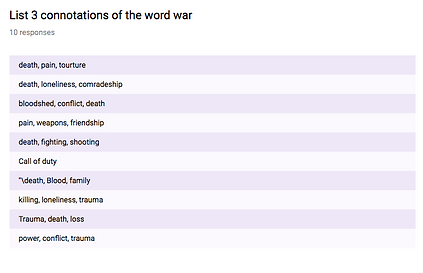
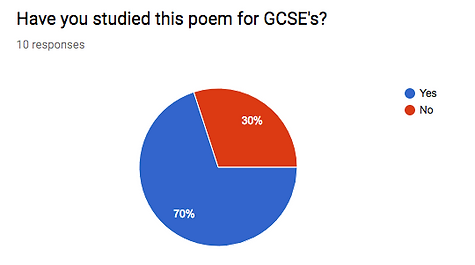

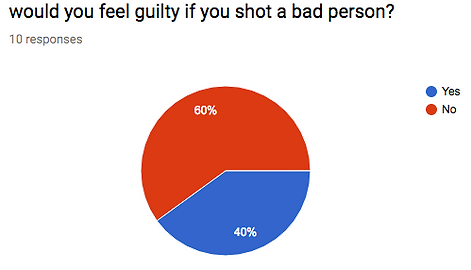

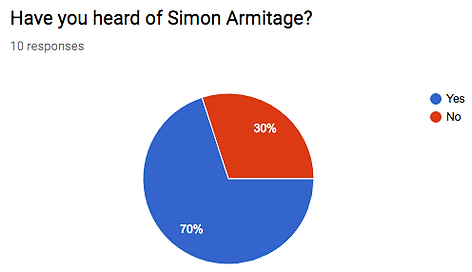
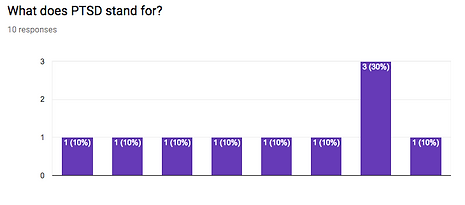

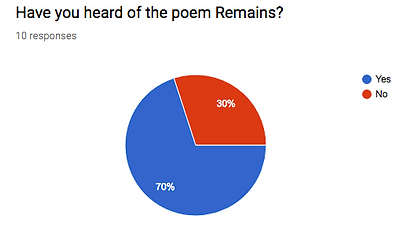
Proposal
Idea- Include lots of flashbacks and keep switching between present day and the past and speed it up to show how the memories are staying with him forever. I will start with the 3 soldiers running down the road and shooting the robber. It will then cut the soldier after the war and having flashbacks and it will show how he has PTSD and how this affects him. I interpret this poem as the soldier showing how he is suffering with PTSD and how the thoughts of war is staying with him even when its over.
My idea in practice
Alexis bank robber
Dom soldier 1
Stephen soldier 2
Peter PTSD person
Alexis-running down the road- have 3 different shots side view,behind shot, front shot
a shot of her lying on the floor
she gets shot and falls to the floor and being dragged away by Stephen
Dom- running down the road at the same time with a gun, behind shot, front shot
Stephen- running down the road with a gun
runs over and drags the body away
Peter- running down the road with a gun, shoots his gun, walking down the street when no one is there and looking down
sitting down on a chair looking distressed
sleeping in chair moving about
holding a bottle of drink while sitting down
Target Audience-D/C2 because these include the working class and the skilled workers which I think will appreciate this poem and can maybe relate to it with their own situations and lives probable not as major as this but still have experiences that stay with them forever.
Pre-production paperwork
Budget- It wouldn't cost too much to shoot this because I am using a lot of the same footage over again, meaning that it also wouldn't take much time to film. I used the media department equipment rate card to see how much it is going to cost me.
Mac computer with adobe suite: £100
TV studio: £200
Hand microphone:£5
Level 3 year 1 tripod: £15
Panasonic HMC41: £80
Total: £400
Props/costumes-I will need to have 3 fake guns for the 3 soldiers to have at the beginning. A bottle of drink for the soldier with PTSD, a black hat for the bank robber, a big black bag to suggest that it has money in or weapons.
Treatment- This poem is about a soldier who has killed people in war and how it affects him afterwards as he suffers with PTSD. The first part of the poem is set in the past and he is describing how he had to shoot a robber and the second half of the poem is the after effects of war. I think that the poet is trying to communicate the effects of war on a soldier and that afterwards life doesn't go back to normal.
Storyboard
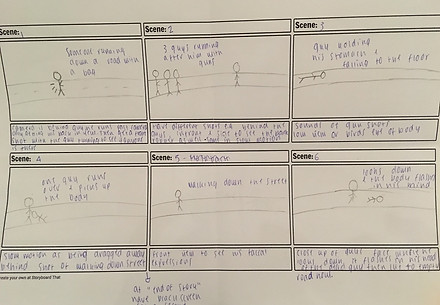
Primary Research
I made a google form to help me understand what other people understanding and knowledge is of the subject.
Do you know anyone that went to war?
6 people said that they knew at least one person who went to war. I think that this is quite shocking to know that the majority of people know someone who went to war.
How would you feel if you shot someone at war?
The responses ranged from having no feelings, or being unsure and people not knowing how they would feel if it happened. Others said that they would feel guilty and would cry. These responses are what I expected because every person is different and they would respond in different ways.
List 3 connotations of the word war
From the results I got in 50% of them said that death was one of their connotations other examples that were also used was pain and torture, loneliness and trauma.
Have you heard of the poem remains?
70% of people said that they had heard of the poem proving that it was very popular and of that 70% only 44% actually like it meaning that the majority of people 't like the poem.
Have you studied this poem for GCSE's?
Similarly 70% people said that they have studied this poem for GCSE's which suggests that the people that heard of the poem before was only because of GCSE's.
If yes do you like it?
44.4% of people said that they liked the poem, and 55.6% said that they don't like it. This shows that the majority of people don't like the poem.
Have you heard of Simon Armitage?
These results also show that 70% said yes which again suggests that they have heard of the poem and poet because they had to study it. Although these results could be a coincidence, but none the less it still shows that the majority of the people have read the poem.
What does PTSD stand for?
4 people said that they didn't know what PTSD stood for which is surprising as I thought more people wouldn't have known what it means. Some people had heard of it but didn't know exactly what it stood for.
Would you feel guilty if you shot a bad person?
60% of people said that they wouldn't feel guilty if they shot a bad person which is quite shocking to me as I thought it would be less.
Do you know anyone with PTSD?
60% said they didn't know anyone with a PTSD but 40% is still quite a high percentage of people that know someone with this disorder.
After analysing all the primary research I have come to a conclusion that a lot of people had heard of this poem and had heard of the poet. However, more of the people dislike the poem than people who do like it. The majority of people understand or have heard of PTSD which shows that most of the people will understand the poem and will be able to connect with the poem more. A lot of the connotations of the word war is death, which is one of the main focuses of this poem. However, not one answer said PTSD which suggests that when people think of war they think of what it is like in the moment rather than the after effects of it. This information has helped me with my own visual narrative as I am now going to make sure that I convey PTSD in a most realistic way as possible to give people a better insight on it and so that they understand how serious the effects of war has on soldiers.
Pitch
I am going to have 3 people who are going to act as the soldiers, to chase a robber down the road and for them to shoot at him. The person dies and gets taken away, but then it shows the after effects of this and how the person copes with having PTSD. It is going to contain the soldier walking down the road having flashbacks, and being in his house with flashbacks in between to show how the visions are staying with him even though it is over. As I narrate the poem I will speed up to show how the visions are vivid. Dom and Stephen are going to be 2 of the soldiers, and Peter is going to be the soldier who gets the PTSD and shows the effects of war has on him. Alexis is going to be the robber who gets killed. I will film outside for the flashbacks, and in the filming studio for the present day parts. I did secondary research on PTSD so that I would be able to portray the soldier in a realistic way for someone who has this disorder. I also did primary research which helped me to understand how much people knew about PTSD so that I can make sure that it is a main focus for my visual narrative to portray it in a correct and serious manner.

Agreements to film/Permission forms
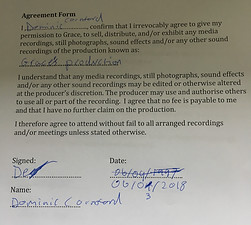
I got permission forms for me to film them and for them to agree to be in my video.
Location Reports
Location- I will be filming this visual narrative in the filming studio and outside. I will have to film the flashback parts outside, and the close ups of the person now will be filmed inside using a white background and the studio lights to make it more professional. The risks of filming in the studio is walking into the lights or touching the lights as they are very hot. To prevent this from happening I will make sure the lights are above head height. There could be a risk of tripping over cables but this would be a low risk as I will make sure that there are not many about and it is organised.
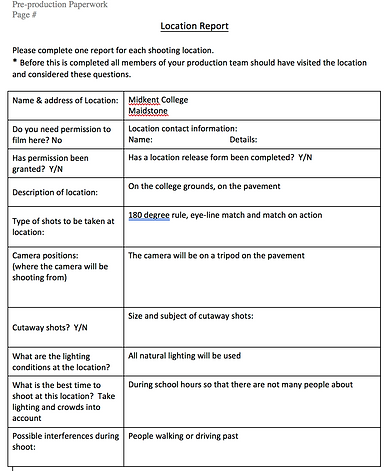
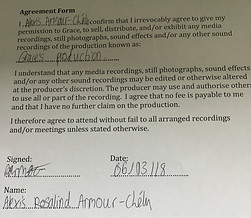
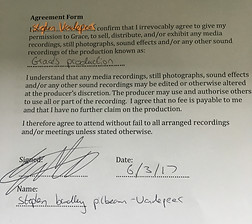
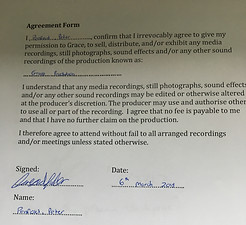
Call sheets
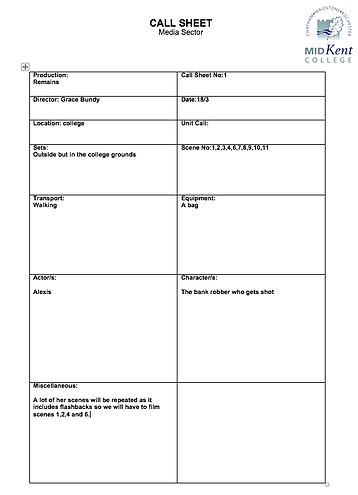
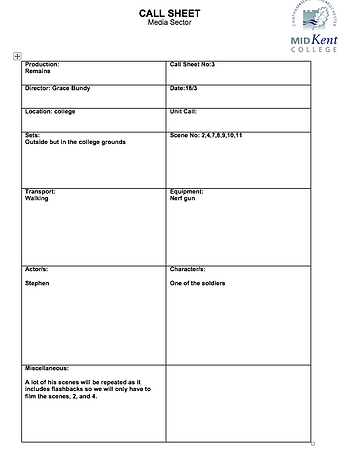
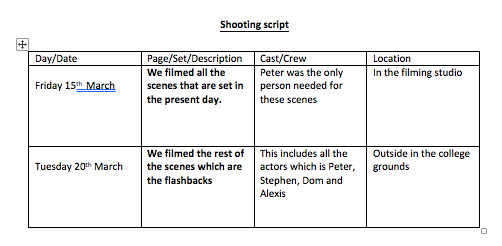
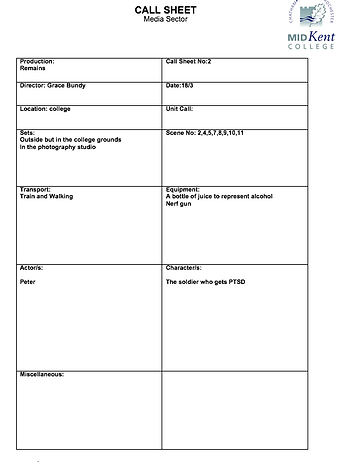

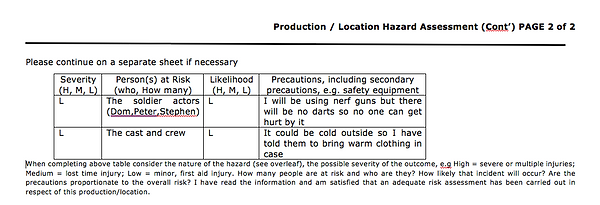
Risk assessment- When filming outside we will have to film on the pavement to make sure that we are safe. There is a risk of the equipment getting wet due to the weather so I will make sure that we only film outside when it isn't raining. There will need to be people running so I will pick an area to film that is as flat and as safe as possible.
